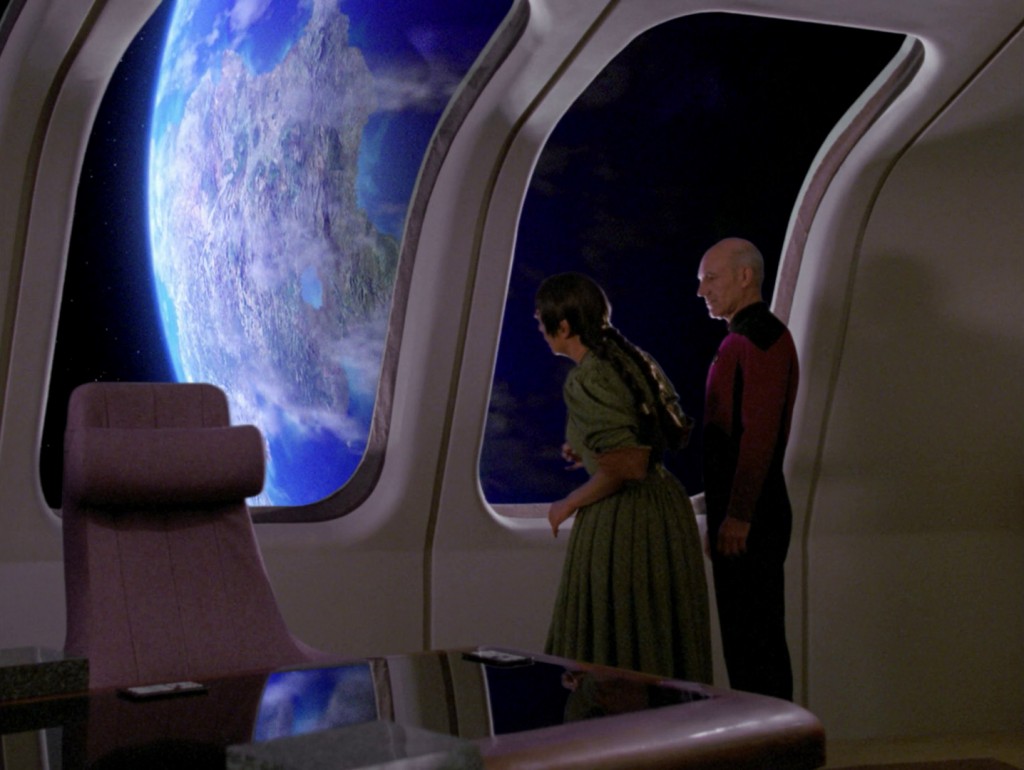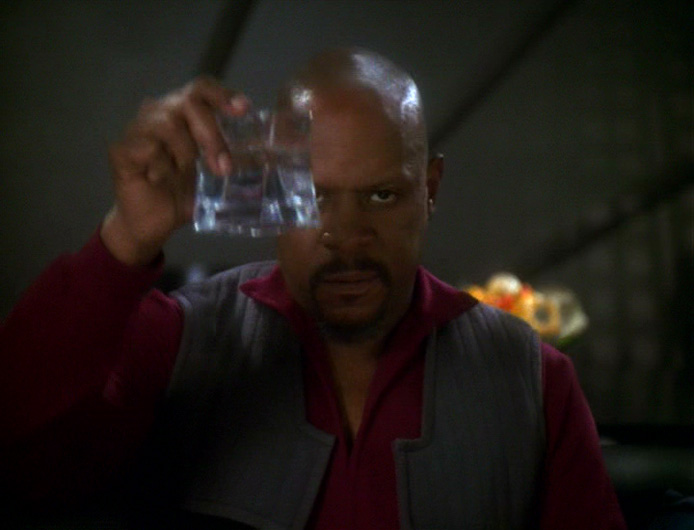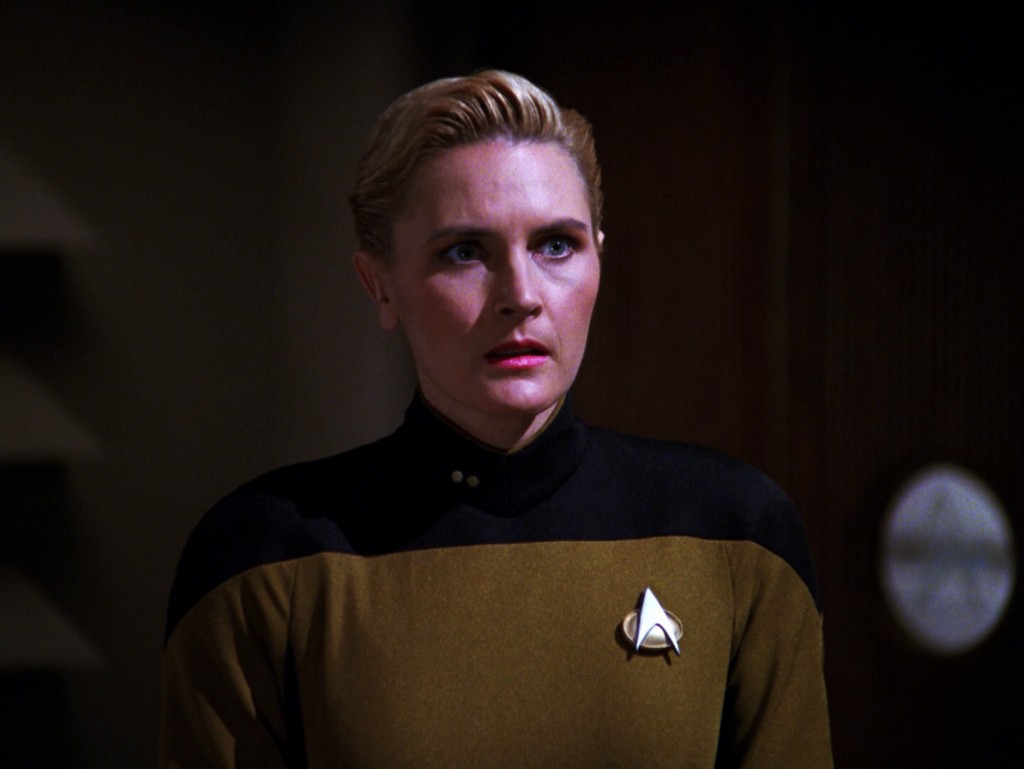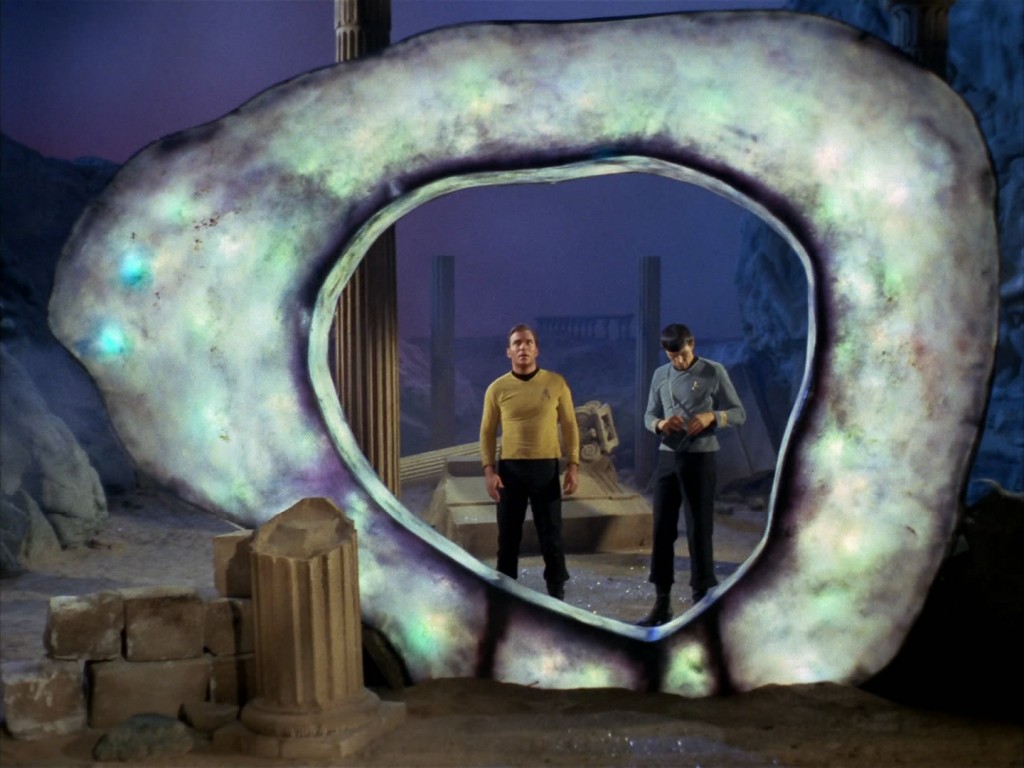On September 8th, 2016, the Star Trek franchise will officially turn 50, and what better way to celebrate than to count down the 50 greatest Star Trek stories in the canon? Deadshirt Founder and Editor Emeritus Dylan Roth pored through the 728 episodes and films to select the Top 50 Star Trek Voyages.
#10: “Family”
Star Trek: The Next Generation
Season Four, Episode Two
Originally released October 1st, 1990
Written by Ronald D. Moore
Directed by Les Landau
At the end of any given episode of The Next Generation, the Enterprise warps away and leaves the baggage of the current story behind them. That’s the nature of episodic television, after all. But some stories are so pivotal that they simply can’t be forgotten the following week, and that’s certainly the case with the epic two-parter “The Best of Both Worlds.” In “BOBW,” Captain Picard is captured by the Borg, who plug him into their collective consciousness and force him to lead their invasion of the Federation. Picard is the instrument through which they destroy 39 Starfleet vessels, killing thousands of officers and civilians. If nothing else, after this kind of trauma, Picard deserves some time off.
The Captain returns to his home village of LaBarre, France, where his brother Robert (Jeremy Kemp) has taken over the family vineyard. While his sister-in-law and nephew welcome him with open arms, Robert and Jean-Luc immediately pick up old arguments and bitterness. Robert continually tries to get a rise out of Jean-Luc, while the famously stoic Captain keeps his cool. The thing is, Robert is right—Captain Picard needs to confront his grief, his rage and sorrow over the Borg incident if he’s ever going to move on with his life. The climax of the story allowed Patrick Stewart—who had been growing bored with the role—to rediscover the character of Jean-Luc Picard and deliver one of his greatest performances.
Meanwhile, on the drydocked Enterprise, Worf greets his exuberant, overbearing Human parents, Helena and Sergey Rozhenko (Georgia Brown and Theodore Bikel). While fodder for comedy, it also allows for a glimpse into a side of Worf that neither the crew nor the audience ever gets to see. Like Picard, Worf has recently suffered a grave dishonor—his discommendation from Klingon society—and he needs the unconditional love of his family to make peace with it.
Finally, in another subplot, young Wesley Crusher views a holographic message from his late father, putting them face to face for the first and only time in the series. Wesley has his scars, too, and when the letter ends and Wes quietly says “Goodbye, Dad,” there’s a palpable sense of closure. And that’s what this episode is all about: facing heartbreak, but not facing it alone.
There is no sci-fi twist to this episode, it’s a pure character study. And while that may not be what we typically want in a Star Trek story, just this once, it was exactly what the show needed, and it stands as one of the franchise’s greatest hours.
#9: “Who Watches the Watchers”
Star Trek: The Next Generation
Season Three, Episode Four
Originally aired October 16th, 1989
Written by Richard Manning & Hans Beimler
Directed by Robert Beimler
The rigid network standards of the 1960s required a certain ambiguity on the subject, but in first-run syndication in 1989 there was no need to mince words: Gene Roddenberry’s ideal future humanity does not practice religion. In fact, they seem to find the whole idea repellant, or at least that’s certainly how Jean-Luc Picard feels about it. So it’s hard to imagine a worse nightmare for Picard than to discover that a tribe of Bronze Age proto-Vulcans have mistaken him for their god. Unwilling to allow his accidental intervention in their culture to lead to religious war or oppression, Picard sets out to prove to the Mintakans(sp) that he’s no more divine than they are, while doing as little further harm as possible.
The reason the episode works as well is it does is because of the Mintakans themselves. Rather than portaying then as foolish primatives, the Mintakans are observant and logical (their evolution closely mirrors the Vulcans). The Mintakins are said to have “outgrown” religion millennia ago, but their belief in the Overseer is rekindled by the sudden appearance of physical evidence. It’s this same objectivity and wisdom that makes tribal leader Nuria (Kathryn Leigh Scott) receptive to the truth.
The dark consequences of the Mintakans falling prey to a false god image are represented by Liko (Ray Wise), the man who believes Picard brought him back to life. (In fact, it was Dr. Crusher saving him from the brink, against the Captain’s wishes.) Liko is lonely and desperate, and clings to his faith in Picard in the hope that the all-powerful Overseer will return his dead wife from the grave. He’ll do anything on the off chance it curries his god’s favor, even kill. Liko’s belief is so strong, so blind, that even after Picard himself appears to protest his own godhood, he still won’t listen, and ends up shooting Picard with an arrow to prove he can’t be killed. TNG may not have the most tolerant view of religion (DS9’s is more even-handed), but “Who Watches the Watchers” at least makes an honest effort to humanize even the most terrifying kind of zealot.
#8: “In the Pale Moonlight”
Star Trek: Deep Space Nine
Season Six, Episode Nineteen
Originally aired April 15th, 1998
Story by Peter Allan Fields
Teleplay by Ronald D. Moore
Directed by Victor Lobl
Here it is, the turning point of Deep Space Nine. Everything that makes DS9 different from the preceding shows is turned up to eleven here, leading to a final twist that would be unheard of in any other Star Trek series. Whether or not Gene Roddenberry would have approved is barely up to debate—he’d have hated it. I don’t care.
For the first and only time on this countdown, I’m going to issue a SPOILER WARNING. If you haven’t watched Deep Space Nine and you still plan to, skip the rest of this review and move on to #7. You don’t want this ruined for you.
The Dominion War is going very badly for the Federation and their allies, the Klingon Empire. Things have been worse for the crew of Deep Space Nine, sure—they had to retake the station from the Dominion a few months earlier—but out there, on the front lines, Starfleet is getting demolished. Federation worlds are being conquered, worlds fans have heard of and visited, like Betazed. The only end in sight is the Federation’s unconditional surrender. Unless Benjamin Sisko can convince the neutral Romulan Empire to join the fight, on their side. And the only way to do it may be through lies.
Sisko is presented with a very high-stakes puzzle. The only way to draw the Romulans into the conflict would be to present them with evidence that the Dominion plans to invade them next. And while he believes that to be true, no evidence exists, and if he waits for evidence to present itself, it could be too late to turn the tide of the war. So he and disgraced Cardassian spy Garak (Andrew Robinson) secretly conspire to manufacture the evidence they need. Benjamin Sisko, Starfleet commander, agrees to trick a nation into going to war under false pretenses. Dishonorable. Unconscionable. Absolutely necessary.
But it gets worse, as Sisko realizes that working with Garak means nothing is off limits. Garak doesn’t care about Sisko’s values, about Federation rules. He cares about getting the job done and freeing Cardassia from Dominion rule. When the plan goes south and Romulan Senator Vreenak (Stephen McHattie) discovers the forgery, Sisko believes that he’s failed, and maybe made things worse. Then Vreenak turns up dead, his vessel sabotaged, apparently by the Dominion, but actually by Garak, for whom this was the plan the entire time. He knew the forgery wouldn’t hold up, but if it was discovered, damaged, in the hands of a murdered Romulan ambassador, it might just be enough to fool the Romulan Senate and inspire them to declare war against the Dominion. Sisko gets what he wants, he’s maybe even saved the Federation, but now he’s an accessory to murder.
“But most damning of all,” Sisko says to his personal log, “I think I can live with it.”
One could point to this moment and say that this is what makes Benjamin Sisko different from Kirk, Picard, or Janeway. (Archer would go on to make similar compromises during the Xindi conflict.) And that’s partially true; Benjamin Sisko is a very different person from the other series leads, more emotional, more morally flexible, even. But really, “In the Pale Moonlight” is about what makes Deep Space Nine different as a series. In other Star Trek series, when a character is presented with an impossible choice to either violate their code or allow a catastrophe, they’re usually let off the hook in one way another. Kirk refuses to kill the Gorn in “Arena,” and that ends up impressing his captors more than a bloody victory. Picard doesn’t send Hugh back to the Borg Collective with a genocidal logic bomb in “I Borg,” and despite his future conflicts with the Borg, he’s never really made to regret that decision. And that’s good! That’s what Star Trek is about, holding to the ideals of truth and compassion in the face of adversity.
But what about when fate doesn’t offer you a way out? What if Kirk had to either kill the disabled Gorn or else the Metrons would blink humanity out of existence? What if, in “I Borg,” there was another cube a few light years from Earth and the invasive program may be the only way to stop the Borg before they assimilate everyone? What’s the more heroic thing to do: to stick to your guns and die, along with your entire civilization, rather than violate your code? Or to sacrifice your individual integrity and self-respect, to sacrifice your soul so that others can keep their own? “In the Pale Moonlight” dares to put its hero in that situation, when The Next Generation never would. And while that might make Deep Space Nine a less pure example of the Star Trek philosophy, ultimately this is what makes it a better television show.
#7: “Yesterday’s Enterprise”
Star Trek: The Next Generation
Season Three, Episode Fifteen
Originally aired February 19th, 1990
Story by Trent Christopher Ganino & Eric A. Stillwell
Teleplay by Ira Steven Behr & Richard Manning & Hans Biemler & Ronald D. Moore
Directed by David Carson
Under the stewardship of new head writer Michael Piller, The Next Generation had finally found its own voice during its third season. There were a number of course corrections—the new uniforms, the return of Gates McFadden as Dr. Crusher, no longer recycling stories from the 60s and 70s—but there were also some mistakes from early on that couldn’t be so easily remedied. For instance, remember that time back in Season One when a member of the main ensemble died a sudden, pointless, undignified death?
Halfway through “Skin of Evil,” the twentieth episode of TNG, Security Chief Lt. Tasha Yar is killed instantly by a single telekinetic blow from a goop monster. Having her die without warning at the beginning of Act Two is novel, in a way; unceremoniously shuffling off nameless security officers is a longstanding Star Trek tradition, but nobody expects it to happen to a series regular. And it’s not as if her demise was forgotten as quickly as your average redshirt’s—Tasha gets a stirring and memorable funeral at the end of the episode, and she gets a handful of mentions later on in the series—but it wasn’t exactly a satisfying send-off for one of the Enterprise’s senior officers. It wasn’t really meant to be.
And two years later, the handling of Lt. Yar’s departure from the show still wasn’t sitting right with the fans, with the writers, and least of all with Denise Crosby, the actress who portrayed her. Back in 1988, Crosby asked to be released from her contract and written out of the series because she felt that her character wasn’t going anywhere and that show kinda sucked. (She wasn’t, and it did.) But now two years had passed, and Star Trek: The Next Generation had very suddenly become a hit show, so naturally she was eating some crow and would have very much liked her old job back. And while that wasn’t in the cards, the producers were interested in having her back as a one-off guest star so they could give her character a more satisfying finale.
In “Yesterday’s Enterprise,” the crew of the NCC-1701-D discovers a ship emerging from a rift in space-time. The moment it appears, life aboard the Enterprise is suddenly different: the lighting on the bridge is now dark and severe; the crew’s uniforms have changed slightly, and everyone is armed; and in place of Worf at the Tactical station is one Lt. Tasha Yar. Lt. Yar quickly identifies the battle-damaged vessel that has appeared in front of them as the Enterprise: NCC-1701-C.
Thanks to the intuition of ageless bartender Guinan (Whoopi Goldberg)—who has the ability to sense changes in the timeline—and the testimony of the E-C’s Captain Rachel Garrett (Tricia O’Neil), Picard and company manage to piece together what has happened. 22 years earlier, the Enterprise-C comes to the aid of a Klingon outpost that is under attack by the Romulans, but then vanishes. A short time later, tensions between the Federation and the Klingons flare up into a full scale war that costs billions of lives. Now, the Federation is on the ropes, and their only hope of surviving the war may be preventing it from ever happening. Guinan is certain that this war is not supposed to be happening at all, and that sending the E-C back through the rift is the key to correcting the timeline, but returning to the battle with the Romulans will also mean certain death for her already decimated crew. Captain Garrett, like any brave Starfleet Captain would, agrees to make that sacrifice for the greater good, and readies the ship to return to the past.
But, remember, this episode is really about Tasha Yar.
When the Enterprise-C arrives in the present, Lt. Yar is part of the rescue team that finds Captain Garrett and the only other surviving bridge officer, Lt. Richard Castille (Christopher MacDonald). Tasha and Castille hit it off immediately, and as the E-C prepares for its doomed voyage, the would-be lovers are about to be separated by two decades and the veil of death. But something goes wrong—the two Enterprises are ambushed by Klingons in the present, and Captain Garrett is killed, leaving Castille the old Enterprise’s last surviving bridge officer. Whatever difference the E-C is meant to make in the battle 22 years ago, there’s no way they’re going to make it without either an experienced commander or tactical officer aboard.
That’s where Tasha comes in. Somehow, Tasha knows she’s not supposed to be here. Like Guinan, she can sense the wrongness of this universe, and when she confronts Guinan, Guinan confirms for her that the two of them were never meant to meet, that in the other timeline, Tasha dies an empty, senseless death. Knowing that the success of the E-C’s mission will mean her erasure from time, Tasha volunteers to join the doomed crew and die to prevent the war. This time, her death will mean something.
“Yesterday’s Enterprise” nails it on every level, from Tasha’s story, to the subtle differences in the characters’ interactions in the alternate timeline, to the outstanding production value. It’s no surprise that this episode’s director David Carson would be called upon to helm this show’s first feature film five years later. It’s an episode with great cosmic and emotional stakes, and it elevated Tasha Yar from a Season One curio to a bona fide hero.
#6: “The City on the Edge of Forever”
Star Trek
Season One, Episode Twenty-Eight
Originally aired April 6th, 1967
Written by Harlan Ellison
Directed by Joseph Pevney
“The City on the Edge of Forever” didn’t make the Top 5? Scandal! Since its debut at the tail end of Star Trek’s groundbreaking first season, this episode has been hailed as a triumph of science fiction, one of the greatest hours in the history of television. It won the franchise its first Hugo Award. It tops nearly every ranking of The Original Series or the franchise at large. It does not top this one. Blame my age, my bias toward the Next Gen era, if you like, or my inclusion of the films the list. It ain’t the champ.
Which isn’t to say that “City on the Edge” isn’t an outstanding piece of science fiction television. In this story, a drugged Dr. McCoy is accidentally swept into Earth’s past by the Guardian of Forever, an ancient device of mysterious origins. Somehow, McCoy’s presence in 1930s New York has a catastrophic effect on the future, and Kirk and Spock must venture back to correct the damage. What follows is a story that blends high drama, tragic romance, fish out of water comedy, and Star Trek’s famous optimism in a way that has stood up to fifty years of re-watching.
The presence of this episode toward the top of this list goes without saying, so forgive me if I dedicate more of this review to pointing out its flaws and justifying its placement on the list than I do to praising its many strengths. Fans and critics have been rightly praising “The City on the Edge of Forever” for fifty years. It is the best television episode to come out of the original Star Trek. On a story, performance, and production level, it stands far above the rest. But it doesn’t do what Star Trek does best, which is teach you something. There’s not a lot to chew on in “City on the Edge,” not a lot to talk about when it’s over. It’s a marvelous character piece and a strong time travel story. But future Star Trek stories would combine this level of storytelling with the core of what makes Star Trek great, which is the ability to challenge your preconceived notions of the world around you and ask you to see it differently from now on.
On a final note—and this is a matter of personal taste—I don’t believe, nor do I like the idea, that the Star Trek franchise peaked in 1967. Not when there’s half a century of great stories that have been told since. And in the next and final installment of The Top 50 Star Trek Voyages, I plan to demonstrate why.
The Top 5 will be revealed this Thursday, on Star Trek‘s 50th birthday.






